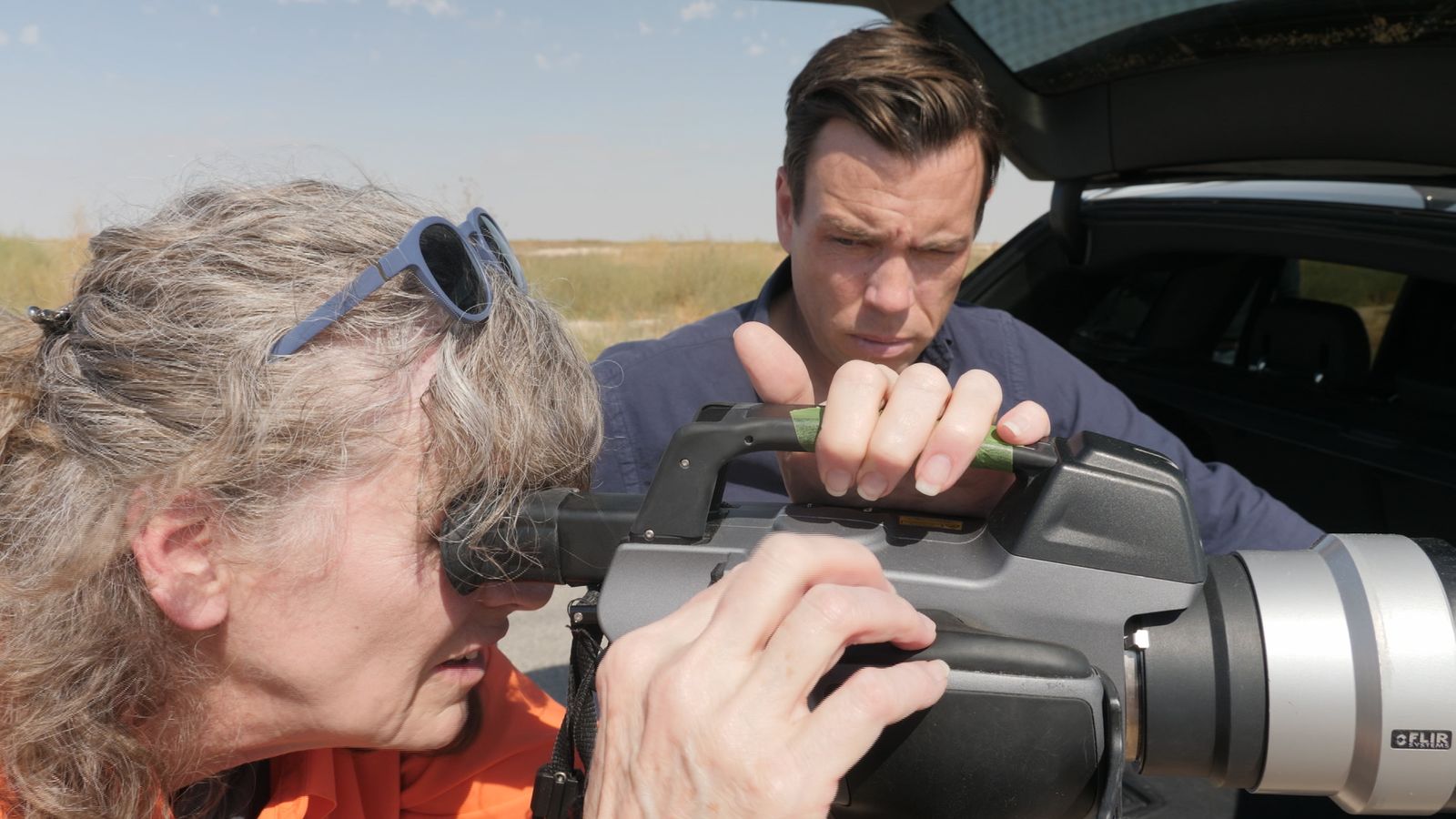The frontlines of this climate crisis are well-known: low-lying nations like the Seychelles, Grenada, Bangladesh which face such catastrophe and of course the many weather-battered regions of our planet.
But what about the other frontlines – the places where the demand for action comes up against the resistance to change?
We’ve travelled to Texas, the land of black gold, to meet a woman who is so determined to affect change and yet strikingly pessimistic that she can help achieve it.
The methane hunter
Sharon Wilson is a methane hunter. For nearly two decades she has dedicated her life to exposing the invisible impact that methane is having on our planet. Once an employee in the oil industry, she is now a senior field researcher for the clean air advocates, Earthworks.
We meet in the Permian Basin, a vast American desert landscape, and the heart of America’s oil industry. It’s where the politicians’ promises at the COP26 summit in Glasgow meet the reality on the ground.
COP26: Deforestation, methane and climate finance pledges roll in, amid caution there’s still a ‘long way to go’
COP26: President Biden says China’s failure to attend climate summit a ‘big mistake’
COP26 news live: Joe Biden lashes out at Russia’s Vladimir Putin over climate inaction
If the United States is to lead the way in the climate change crisis – as President Joe Biden says it will – then the Permian Basin is one part of a frontline that will make the difference between success and catastrophe.
On the side of the road, next to one of the thousands of oil facilities dotting this landscape, Sharon sets up a specialist camera. This is her tool to expose methane leaks which she says are everywhere.
“Let me set this to high sensitivity mode,” she says, pointing the camera towards a series of huge tanks. To the naked eye, nothing is visible.
However, through the viewfinder, a constant and think plume of vapour is clearly emerging.
She explains that it’s methane and that it needs to be released from the tanks, which contain crude oil, to release pressure.
In some instances, the methane is captured using vapour recovery units. In other cases, it is funnelled to flares which are supposed to be lit to burn it off.
But her research has shown that so often, the recovery units are not used and the flares are not lit. Even when the sites are operating within the rules, there is a problem with both the recovery units and the flares.
A false solution
The roaring flares are a common sight across all oil-producing landscapes. They burn off methane, which is a byproduct of oil production, turning it into carbon dioxide.
If a flare is lit, it is still polluting the landscape by increasing atmosphere-warming CO2 levels. But a lit flare is less damaging than an unlit, or partially lit, flare which is emitting methane straight into the landscape.
“I used to believe that vapour recovery systems would be the holy grail,” Sharon tells me.
“I no longer believe that. It is another false solution. I see them failing all the time. Right back there where we stopped a few minutes ago, they have a brand new vapour recovery and there’s a lot of emissions coming from the tanks,” she says.
We stop at another site where a huge flare stack is not lit and appears to be idle.
But through her lens, the view is shocking: plumes of emissions are pouring out.
“Why isn’t it lit?” I ask.
“I’ve been reporting it to the state every time. I guess nobody makes them,” she replies.
“Who’s going to make them light it? I’ve been reporting it to the [regulator].”
She says it leaves her “not hopeful about the prospect of trying to regulate this industry”.
“I mean, if you looked out the window when you flew here, this is everywhere. It’s everywhere. You’ve only seen the head of a pin of what’s out here, and the industry will dodge responsibility at every turn.
“They will maliciously dump methane into the air just to get rid of it – and they don’t suffer any consequences because of that. So why should they care?”
The problem with methane
We’ve all heard about the problem with carbon dioxide: it warms our planet and is the key contributor to our rising temperatures, melting ice-caps and rising sea levels.
But in the short term, methane is far more damaging.
A seminal UN report, published in May, found that immediate reductions in methane emissions are the best, swiftest chance the planet has at slowing climate change.
If we can collectively stem the emissions of methane, then, the argument goes, we can buy ourselves time while the harder task of cutting CO2, or capturing it, can be achieved.
Colin Leyden is from America’s Environmental Defense Fund.
“Methane, which is the primary ingredient of natural gas, is a very potent climate pollutant,” he tells me.
“It’s about 84 times more potent than the climate pollutant we all know about – carbon dioxide. The good news is that while it’s more potent, it’s also shorter-lived. And the issue is that when oil and gas companies go out and drill for oil, natural gas, methane comes up with that oil and how they manage that.”
Mr Leyden believes that a fix is within reach if government and industry can cooperate and enforcement is successful.
“What we’re essentially talking about is a plumbing problem – it’s making sure that the methane is not escaping through leaks in pipes and valves and other equipment – flares,” he says.
If the ‘plumbing’ issue could be fixed, then the methane could be collected and sold to the market to power homes or cars. But Mr Layden says this is not the priority for the oil industry.
“Maybe they don’t want to spend the money to get the gas to market because they’re really there for the oil. And so they burn it in the oil field.
“Now it’s better to burn it than it is to release it directly into the atmosphere. But when those flares don’t work correctly, when they malfunction, then you’ve got the methane going directly into the atmosphere.”
The quick fix?
Of all the bold pledges to come from Glasgow, methane is being sold as the quick fix – the swiftest chance we have to turn things around and save our planet.
The Global Methane Pledge, endorsed on Tuesday in Glasgow by nearly 100 countries, and announced by President Biden, seeks to cut global methane emissions by at least 30% by 2030. This would, they hope, slow the forecasted warming of the planet by over 0.2 degrees centigrade.
Please use Chrome browser for a more accessible video player
But Sharon Wilson, who has taken the Earthworks research to Glasgow, remains very sceptical.
She says: “I’ve been hearing that for 10 years now. If you look at the chart of methane, it just keeps climbing higher. We’re going the wrong way. Nothing has changed, except the industry has kept expanding, and methane and volatile organic compounds are worse.
“I don’t think that Joe Biden has ever been out in the field. I would be happy to take him out in the field with me. I don’t think any of them have ever been out in the field. They talk to the industry and they talk to other people who sit in the office all day.
“Those people have not been out here on the ground for years like I have. I lived in the middle of it. I sat on the side of the road for two decades watching this industry.”
Pledges versus people
Up the road in a local town, an industry oil fair hints at just how vital the oil industry is to this region. This is where the grand pledges are up against local politics, jobs and people.
“What are regulations going to do? I mean, how do you regulate the climate?” one participant tells me. “It changed in the dark ages, it’s changed throughout history.”
“What do you think of climate change?” I ask him.
“It’s bulls***. That’s it.”
Another tells me: “I think there’s a lot of regulatory things that they put out there but nobody really super adheres to them.”
Their views are replaced among many here.
Most were too dismissive about climate change even to agree to talk to us.
The industry responds
We approached the three companies who own the plants where we saw the emissions. Only one responded.
Diamondback Energy Inc. said: “Following your inquiry, members of our field team visited the site in question.
“While we agree there appear to be emissions from one tank… the tank from which these emissions appear to be leaking is not owned or operated by Diamondback. It is part of a salt water disposal (SWD) facility that the company divested to an unrelated third party in December 2020.”
Follow the Daily podcast on Apple Podcasts, Google Podcasts, Spotify, Spreaker
The company added: “In 2021 Diamondback established long-term goals of reducing methane intensity by 70% from 2019 levels by 2024.”
Sharon Wilson has taken her imagery to the COP26 conference. She welcomes the renewed interest in the damage methane is doing. But she is not optimistic that change will come soon.
For full coverage of COP26, watch Climate Live on Sky channel 525.
Follow live coverage on web and app with our dedicated live blog.
Get all the latest stories, special reports and in depth analysis at skynews.com/cop26






















